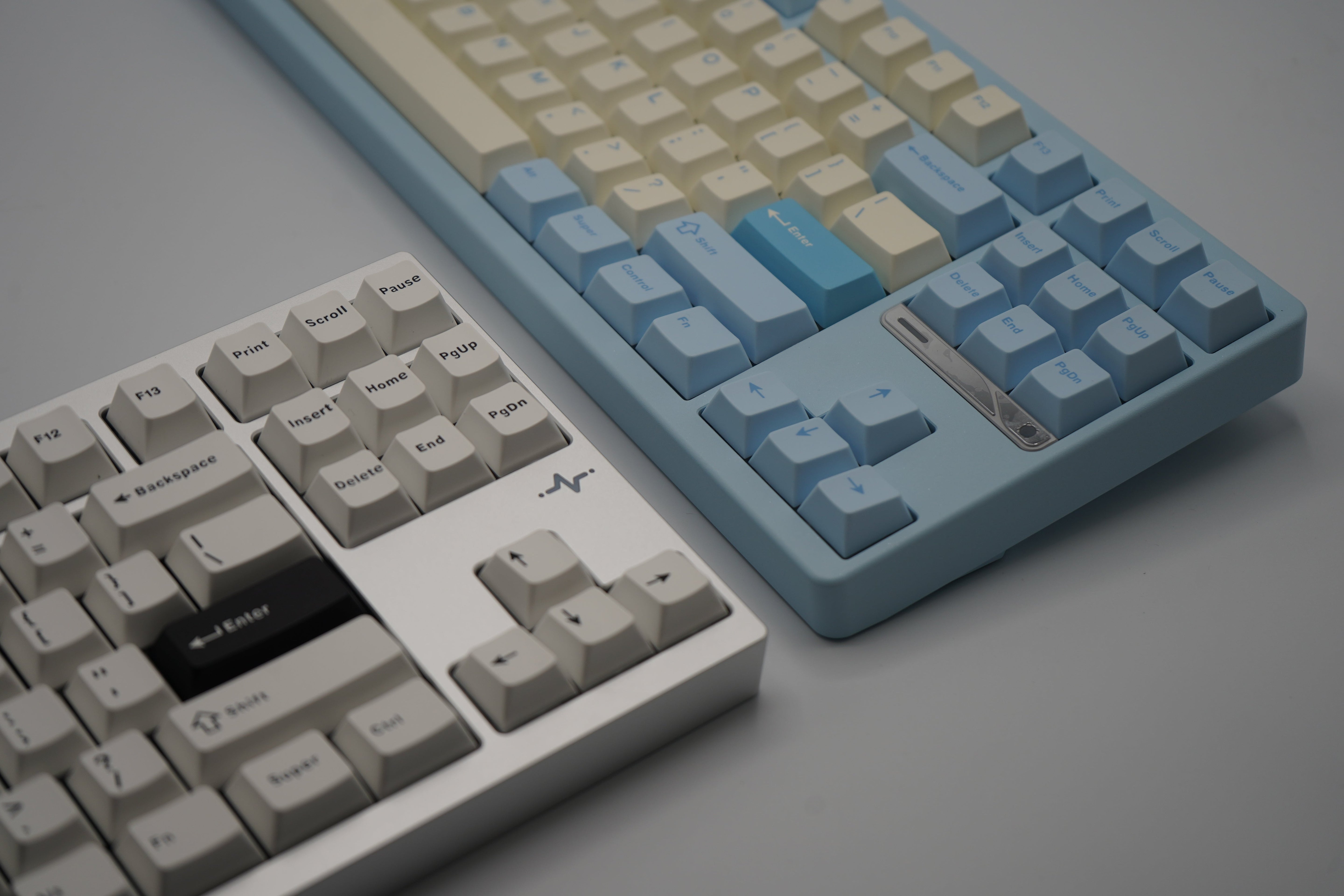Overview
Following the wave of the prebuilt 75% layout custom mechanical keyboards, prebuilt 80%, or TKL (tenkeyless), have entered the market to offer another layout option for users to choose from. Two of the most talked about prebuilt TKLs are the Evoworks Evo80 and the WOBKEY Crush80. Both mechanical keyboards are offered at similar price points and both offer an exceptional build quality. So which one should you buy? Let's take a look at some of the similarities and differences between the Evo80 and the Crush80.
Product Details

Key Design Features
The Evo80 and the Crush80 both have a F13 F-row with an ANSI bottom row layout. They each feature their own design elements in the space between the navigation keys and the arrow keys that distinguishes them from each other. They both feature a multi-layered/multi-colored bottom case designs that pushes the limits of premium design elements that would usually only be seen at a higher price tag.
For the top case:
-
Evo80 has a mirror finished accent below the navigation keys where the LED indicator lights are. The mirror finished accent mimics the back weight which creates a pleasant continuity from the top to the bottom case. The edges of the Evo80 are slightly more rounded than the edges of the Crush80, giving it a relatively softer look from the view from the top case.

-
Crush80 has an LED heartbeat logo below the navigation keys. The edges of the Crush80 are rounded but slightly less rounded than the Evo80, giving the Crush80 a sleeker and more industrial look than the Evo80.

For the bottom case:
-
Evo80 has a multi-layered design with a backpiece that is a separate color from the bottom case, and layered on top of that backpiece is another two-piece weight design that comes in a variety of color as well.


- Crush80 has a bottom case with a multi-color layer look as well. The separate colored backpiece houses the battery, and layered on top of that separate backpiece is weight with the option of either mirror finished or stone finished. And in the center of the weight is a badge, similar to the badges used in the QK65 V2 and Matrix keyboards, that displays their logo. The badge is also attached magnetically to the bottom case and houses the 2.4gHz dongle within.


For the internals:
- Evo80 comes a tri-mode ANSI hotswap PCB with flex-cuts and per-key RGB. There will be two combination options for plates and switches: PP plate with Oat linear switches or FR4 plate with Azure linear switches. And topped off with a matching set of dye-sub PBT keycaps. The Evo80 is butterfly leaf spring mounted using gaskets strips which creates its own unique feel. The Evo80 is also built with the quick assembly ball-catch mechanism coupled with magnetic pogo connectors.


- Crush80 is built with a flex-cut hotswap PCB with RGB for the Pro version and no RGB for the Lite version. The Evo80 has two options for plates: a PP plate for the Lite version and a FR4 plate for the Pro version (with an aluminum plate included for the Pro version). The Crush80 also comes with two options for switches: HMX Frost for the Lite version and Kailh Cocoa for the Pro version. The Crush80 is mounted using a familiar feeling dumbbell gasket mount providing a comfortable typing experience. Like the Evo80, the Crush80 is also built with the quick assembly ball-catch mechanism coupled with magnetic pogo connectors.
-


Keyboard Sound
The Evo80 and the Crush80 come prebuilt with plate foam, PCB foam, and case foam installed. In their stock form, they have the foamy sound signature that sounds deep, creamy, and thocky.
With all of the foams removed, neither the Evo80 nor the Crush80 have any case ping or hollowness.
Both the Evo80 and the Crush80 come with factory lubed and high quality PBT keycaps. The Evo80 has switch options for Keygeek Oat linear switches or HMX Azure linear switches, and the Crush80 has switch options for Kailh Cocoa linear switches or HMX Frost linear switches.
Here is a sound test of the Evo80:
Here is a sound test of the Crush80:
Keyboard Feel
In their stock form, with all the foams installed, both the Evo80 and the Crush80 feel relatively similar in terms of flex. Without any foams installed, both the Evo80 and the Crush80 become incredibly flexible and bouncy due to there being more space underneath the plate/PCB chassis. It should be noted that if you are planning to use the Evo80 or the Crush80 without any foam, that you should still include the plastic film on the bottom of the case to protect the PCB from shorting and becoming damaged.
With the foams removed, there is more of a difference between the Evo80 and the Crush80 in terms of typing feel. The Evo80 uses a butterfly leaf spring gasket mechanism while the Crush80 uses a silicone dumbbell gasket mechanism.
Build Experience
Since the Evo80 and Crus80 come prebuilt, the initial build experience is mostly comprised of the unboxing and setup experience. Both mechanical keyboards are perfectly tuned to use straight out of the box, but for those who are interested in tinkering with different configs (keycaps, switches, mounting, etc) here are our thoughts on the build experiences for the Evo80 and the Crush80.
Both the Evo80 and the Crush80 have a screwless quick assembly system using a ball-catch mechanism. This makes them effortlessly easy to open to try out different configs since the ball-catch mechanism allows the top case to be unlatched from the bottom case without any unscrewing necessary. They also both make use of magnetic pogo pin connectors to connect the PCB to the daughterboard making assembly/disassembly even easier without having to worry about wires or cables.
Both the Evo80 and the Crush80 have options for flex cuts on their plate and PCBs. It should be noted that these flex cuts make inserting and removing switches more difficult. When trying to remove switches the plate/PCB assembly flexes up and when trying to insert switches the plate/PCB assembly flexes down which make it difficult to fully seat the switch. It is recommended to fully open the case and remove the plate/PCB assembly when swapping out switches to prevent any damage to PCB or keyboard components. We would also recommend to use a plate fork (or tweezers if no plate fork) to help support the flex cut plate when inserting switches.
Things to Note
Even though these keyboards have a hotswap PCB, which is meant to make swapping switches easy, it is highly recommended that you disassemble the keyboard to fully take out the PCB and support the back of the hotswap sockets to prevent any potential damage to the hotswap contact points or potential for the hotswap sockets popping out.
For software, both the Evo80 and the Crush80 support VIA compatibility.
Conclusion
The Evoworks Evo80 and the WOBKEY Crush80 are both great options for a custom mechanical keyboard that sounds and feels premium at an entry level price.
There are several elements to consider between the Evo80 and the Crush, like software compatibility, colors, typing angle, front height, and other features. But to simplify the choice, here are our thoughts.
Evo80:
- If you prefer the typing feel of a butterfly leaf spring mount
- If you prefer the Evo80's colorways
- If you prefer to get a mechanical keyboard from a maker associated with Qwertykeys and Neo.
Crush80:
- If you prefer the typing feel of a silicone gasket mount
- If you prefer the option for a configuration with a larger battery
- If you prefer the Crush80's colorways
- If you prefer to have the 2.4GHz dongle receiver to be housed within the bottom case
- If you want the option for two different price points.
You can find these mechanical keyboards in our shop. The Crush80 in stock and the Evo80 for pre-order.
Other Reading
Top 10 Mechanical Keyboard Switches You Need to Know About in 2024
Top Mechanical Keyboard Layouts: Which One is Right for You?
How to Build Your First Mechanical Keyboards: A Step-by-Step Guide
HMX Violet and JWK WOB | Rainy75 Switch Review
Gazzew Boba U4T Tactile Switch Review
Sarokeys Strawberry Wine V2 Linear Switch Review
HMX Cheese Linear Switch Review
HMX Macchiato Linear Switch Review
Cherry MX Black Clear Top "Nixie" Linear Switch Review
Durock Silent Switches Review | Dolphin, Shrimp, Daybreak Silent Switches


Share:
Evoworks Evo80 Keyboard Full Review
Where Are The Tactiles? Gateron Mini I and Gateron Green Apple